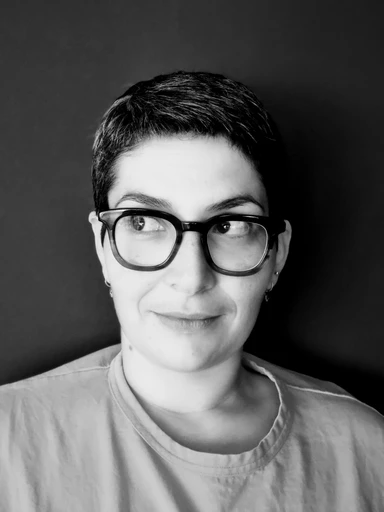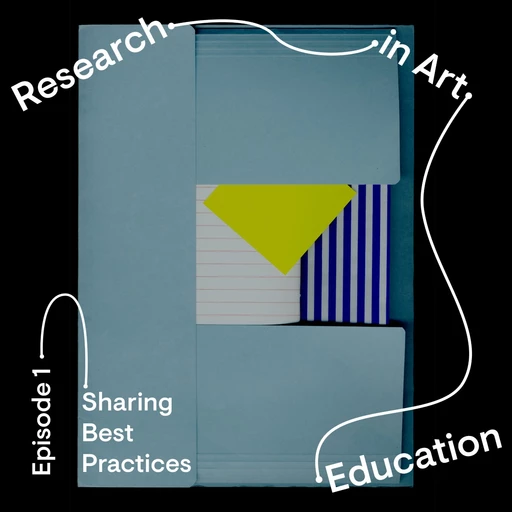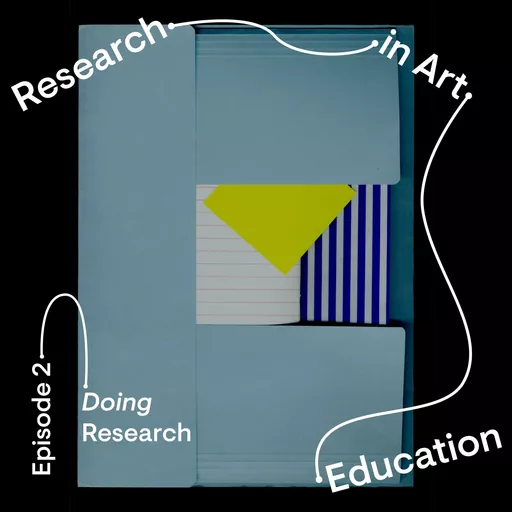
Research in Art Education | Episode 2: The Circle of Doing Research
podcast by Fabiola Camuti – 01 nov. 2023topic: Future Art School
How do we work with research within our educational programs? Which methods do we need and use? And what does this mean for BA and MA students?
In the podcast series Research in Art Education, Fabiola Camuti interviews students, researchers, teachers, and managers working in university of the arts to discuss the importance, challenges, and possibilities of conducting research within arts academies.
The KUO (national art education sector) Strategic Plan 2021-2025 identifies ‘research’ as one of the three key areas art universities should focus on in the coming years. Research is essential not only to the arts and professional art education, but also to our relationship with the world and society. Research already takes on an important role within universities of the arts, however, practices and ideas on the role, methods, ways of conducting research and its embedment within each and every institution, still leave space for further development, investigation, and actions to be taken. For this reason, starting 2022, a national ‘Research in Education working group’ works together to strengthen the knowledge ecosystem and the research culture within our academies. This podcast series is connected to the events organized by the working group around the question: how can we make research sustainable in our academies? The podcast is sponsored by the Vereniging Hogescholen and hosted by Radio ArtEZ for Studium Generale.
The second episode of the series, titled, The Circle of Doing Research: a tool for art students, addresses the possibilities and mechanisms of this model, created by teachers-researchers of the Research Station of the Willem de Kooning Academy (WdKA), with and for the educational departments.
Joining the conversation are the developers of the circle, Miriam Rasch, philosopher, writer, and coordinator of the Research Station at the WdKA, Jojanneke Gijsen, researcher, art historian, and art educational developer, and Harma Staal, graphic designer and educational developer.
You can listen to the conversation in the podcast on Radio ArtEZ and can read more about the Circle in the following text.
In the podcast series Research in Art Education, Fabiola Camuti interviews students, researchers, teachers, and managers working in university of the arts to discuss the importance, challenges, and possibilities of conducting research within arts academies.
The KUO (national art education sector) Strategic Plan 2021-2025 identifies ‘research’ as one of the three key areas art universities should focus on in the coming years. Research is essential not only to the arts and professional art education, but also to our relationship with the world and society. Research already takes on an important role within universities of the arts, however, practices and ideas on the role, methods, ways of conducting research and its embedment within each and every institution, still leave space for further development, investigation, and actions to be taken. For this reason, starting 2022, a national ‘Research in Education working group’ works together to strengthen the knowledge ecosystem and the research culture within our academies. This podcast series is connected to the events organized by the working group around the question: how can we make research sustainable in our academies? The podcast is sponsored by the Vereniging Hogescholen and hosted by Radio ArtEZ for Studium Generale.
The second episode of the series, titled, The Circle of Doing Research: a tool for art students, addresses the possibilities and mechanisms of this model, created by teachers-researchers of the Research Station of the Willem de Kooning Academy (WdKA), with and for the educational departments.
Joining the conversation are the developers of the circle, Miriam Rasch, philosopher, writer, and coordinator of the Research Station at the WdKA, Jojanneke Gijsen, researcher, art historian, and art educational developer, and Harma Staal, graphic designer and educational developer.
You can listen to the conversation in the podcast on Radio ArtEZ and can read more about the Circle in the following text.
The Circle of Doing Research
by Miriam Rasch, Harma Staal, Jojanneke Gijsen
What might a learning trajectory for research look like? What are the different approaches, methods, and contexts to teaching research within an art school? Seeking a broad yet detailed grasp of research education, the Research Station of the Willem de Kooning Academy, Rotterdam, the Netherlands, held conversations with course leaders and research tutors spanning various disciplines. These conversations resulted in ‘The Circle of Doing Research,’ a model of doing research for both tutors and students and the beginning of a learning journey.
The necessity of clearly delineating the various facets of research in art and design, as well as establishing a shared language for it, was fundamental to our process. We examined how research is described in the curriculum and identified the methods highlighted. We asked course leaders and teachers how students are introduced to research and how their understanding of it develops over time.
The Circle of Doing Research is a hands-on model for initiating and conducting research in arts and design. It uses the figure of the circle to present the research process in a non-linear and non-hierarchical way, allowing for diverse, individual pathways.
The Circle of Doing Research uses ‘Research by Making,’ ‘Participatory Research,’ and ‘Research of Context’ as its basic elements where material and information is generated, and combines these with the actions of ‘Reflecting on Research,’ ‘Documenting Research,’ and ‘Making Public where insights and outcomes are processed.’ The model illustrates the multifaceted nature of research: it emphasizes that it is as much about making as theory and context, and balances participatory action as well as individual reflection.
The Circle of Doing Research empowers students to actively recognise, develop and apply their own making and research approaches and position themselves distinctly as an inquiring maker or making researcher in the field.
The Circle of Doing Research has been successfully integrated into curriculum of the bachelor’s degree at the Willem De Kooning Academy from students’ first weeks right the way through to their graduation.
What might a learning trajectory for research look like? What are the different approaches, methods, and contexts to teaching research within an art school? Seeking a broad yet detailed grasp of research education, the Research Station of the Willem de Kooning Academy, Rotterdam, the Netherlands, held conversations with course leaders and research tutors spanning various disciplines. These conversations resulted in ‘The Circle of Doing Research,’ a model of doing research for both tutors and students and the beginning of a learning journey.
The necessity of clearly delineating the various facets of research in art and design, as well as establishing a shared language for it, was fundamental to our process. We examined how research is described in the curriculum and identified the methods highlighted. We asked course leaders and teachers how students are introduced to research and how their understanding of it develops over time.
The Circle of Doing Research is a hands-on model for initiating and conducting research in arts and design. It uses the figure of the circle to present the research process in a non-linear and non-hierarchical way, allowing for diverse, individual pathways.
The Circle of Doing Research uses ‘Research by Making,’ ‘Participatory Research,’ and ‘Research of Context’ as its basic elements where material and information is generated, and combines these with the actions of ‘Reflecting on Research,’ ‘Documenting Research,’ and ‘Making Public where insights and outcomes are processed.’ The model illustrates the multifaceted nature of research: it emphasizes that it is as much about making as theory and context, and balances participatory action as well as individual reflection.
The Circle of Doing Research empowers students to actively recognise, develop and apply their own making and research approaches and position themselves distinctly as an inquiring maker or making researcher in the field.
The Circle of Doing Research has been successfully integrated into curriculum of the bachelor’s degree at the Willem De Kooning Academy from students’ first weeks right the way through to their graduation.
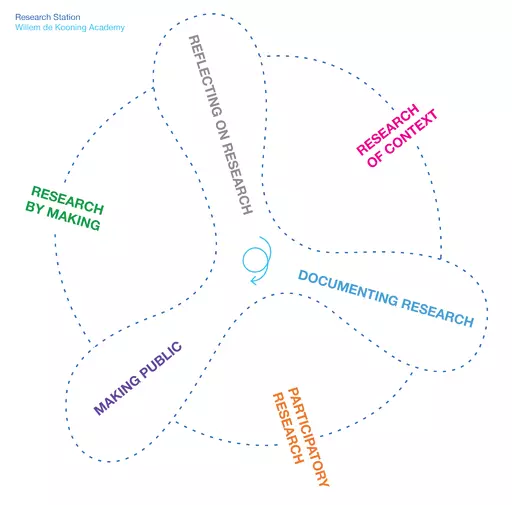

RESEARCH BY MAKING is at the heart of art and design research. It is characterised by activities such as experimentation and prototyping. It involves iteration and continuous reflection on what you do, observe, and decide. Making isn’t limited to material artefacts but may also refer to performance, language, or social and embodied practices. It can be done individually or collaboratively. Making becomes research when it is part of an articulated and shareable process.
RESEARCH OF CONTEXT entails finding and validating sources. They can be visual and textual, artistic and theoretical, human and non-human. Research of context helps you orientate yourself on a subject and its broader scope while also being crucial to reaching in-depth understanding. It thus helps recognising open and urgent questions. It can involve studying existing literature, talking to experts in the field, or examining your own position within a project, system, or organisation.
PARTICIPATORY RESEARCH revolves around working with people. They may be collaborators in your project, have valuable information or experiences around your topic, or they may belong to a certain audience. Interaction, co-creation, and dialogue are ways to bring out their knowledges. You can use tangible materials as support—for example, conversation pieces, cultural probes, or prototypes. Working with others will strengthen your research, but also calls for ethical consideration. What are you offering your participants in return?
DOCUMENTING RESEARCH findings in a deliberate and transferable way is crucial for analysis and reflection. Start with documenting right from the beginning and make sure to make it accessible, for example by using keywords and categories. This will help with argumentation and the representation of your research, both visually and through writing. Collecting, tagging, and structuring different types of information are important actions, both for archiving what you did and for creating a narrative around it.
MAKING PUBLIC is about connecting your research to the outside world. Making public involves writing, designing, organising, and presenting your research in fitting media and spaces. This process doesn’t have to wait until the end of your project but can be an integral part of it. You might create a workshop or open a pop-up store, and then implement what you learned in the next phase of your project. Always consider who the public is and how to relate to the situatedness of knowledge and people.
REFLECTING ON RESEARCH is the undercurrent of any research project, from choosing a topic, methodology, or documentation structure, to analysing observations, experiments, and other (material) data. Taking the next step in an iterative process calls for detailed and structured reflection. It’s also important to consciously consider your own position and role in the project. How does your perspective shape what you do? What are your biases? And what ethical considerations does your subject call forth?
The Circle of Doing Research is licensed under Creative Commons Attribution-NonCommercial-ShareAlike 4.0 International (CC BY-NC-SA 4.0)
RESEARCH OF CONTEXT entails finding and validating sources. They can be visual and textual, artistic and theoretical, human and non-human. Research of context helps you orientate yourself on a subject and its broader scope while also being crucial to reaching in-depth understanding. It thus helps recognising open and urgent questions. It can involve studying existing literature, talking to experts in the field, or examining your own position within a project, system, or organisation.
PARTICIPATORY RESEARCH revolves around working with people. They may be collaborators in your project, have valuable information or experiences around your topic, or they may belong to a certain audience. Interaction, co-creation, and dialogue are ways to bring out their knowledges. You can use tangible materials as support—for example, conversation pieces, cultural probes, or prototypes. Working with others will strengthen your research, but also calls for ethical consideration. What are you offering your participants in return?
DOCUMENTING RESEARCH findings in a deliberate and transferable way is crucial for analysis and reflection. Start with documenting right from the beginning and make sure to make it accessible, for example by using keywords and categories. This will help with argumentation and the representation of your research, both visually and through writing. Collecting, tagging, and structuring different types of information are important actions, both for archiving what you did and for creating a narrative around it.
MAKING PUBLIC is about connecting your research to the outside world. Making public involves writing, designing, organising, and presenting your research in fitting media and spaces. This process doesn’t have to wait until the end of your project but can be an integral part of it. You might create a workshop or open a pop-up store, and then implement what you learned in the next phase of your project. Always consider who the public is and how to relate to the situatedness of knowledge and people.
REFLECTING ON RESEARCH is the undercurrent of any research project, from choosing a topic, methodology, or documentation structure, to analysing observations, experiments, and other (material) data. Taking the next step in an iterative process calls for detailed and structured reflection. It’s also important to consciously consider your own position and role in the project. How does your perspective shape what you do? What are your biases? And what ethical considerations does your subject call forth?
The Circle of Doing Research is licensed under Creative Commons Attribution-NonCommercial-ShareAlike 4.0 International (CC BY-NC-SA 4.0)
The present confronts us with major social, societal, political and climatic issues. Changes are needed to leave a safe, fair and livable world for future generations. The arts are more important than ever. When we look at the world around us from an artistic, creative perspective, we learn to see where the pain and the beauty lie, where the opportunity is, and where we can think again. But are the educational institutions in which artists and art educators are trained still suitable for the new systems, questions and relationships that we need to be prepared for the future? What will the Art School of the Future look like? How will it smell, taste, feel? In the Future Art School series we collect examples and challenging experiments that make us think about art education in the future.
events:
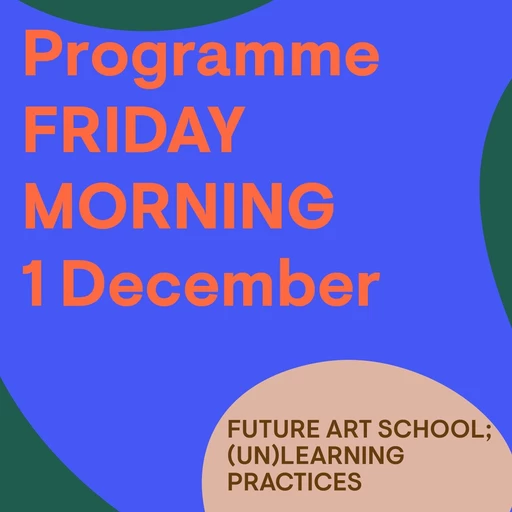
Future Art School; (Un)learning Practices | vrijdag 1 december
Programme Friday 1 December
conference 01 dec. 2023
related content
people – 01 dec. 2023
Fabiola Camuti
podcast – 06 mrt. 2023
